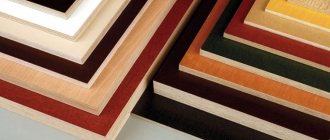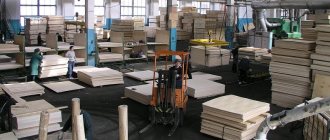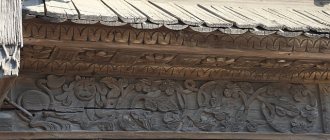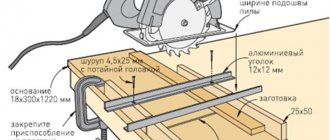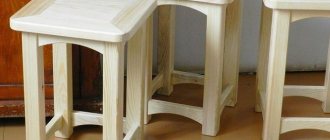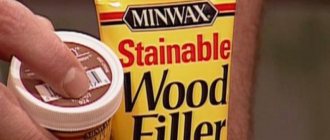Not so long ago, almost the only material for finishing a bathroom was ceramic tiles. The construction industry does not stand still; new materials are constantly emerging. Many people use siding in the bathroom to decorate walls and ceilings, this is explained by its practicality, durability and low price.
Bathroom finished with siding.
Performance properties of siding
Modern PVC panels (also called siding or lining) help create a different style in any room, but are most often used to decorate the bathroom. High moisture resistance, correct geometric shape, simple and reliable connection make it possible to finish a bathroom with siding without extra time and special skills.
There are several types of such material:
- Rack and pinion. Most often they are used to decorate the ceiling, but the slats are also suitable for cladding walls. The width of the slats is 100-125 mm, and the length is 3 m. The slats are connected to each other using a locking connection, which can be wide or narrow. Plain colors or colors imitating wood or other materials are common.
- Standard. In this case, the width of the panels is 250-370 mm, and the length is 2.6-3 m. Tongue-and-tongue locking connections allow for quick and reliable installation. The coating can be plain, imitate other materials, or have a pattern or photo printed on it.
- Sheet. The width of the lamella is 203 mm, and the length is 4.05 m. Finishing with such sheets is done end-to-end, then the seams are filled with sealant in the color of the material. They are most often mounted on a flat surface using glue, but they can also be installed on the sheathing.
Depending on the connection method, the panels are:
- Seamless. Most often they are used to decorate the ceiling. The tight fit of the panels to each other ensures minimal seams.
- With chamfer. Their difference is that there is a chamfer at the junction. They are used for finishing walls and ceilings.
- With decorative surface. Externally, such panels resemble natural lining, but cost more than previous options.
Finishing the bathroom with white siding.
Conclusion
Installing siding is much easier than, for example, laying ceramic tiles on a wall. At the same time, the finish is beautiful, practical and durable. The only thing is that the work must be done carefully and carefully so that the walls are smooth and strong enough.
You can learn more about how siding is installed from the video in this article. If any points are unclear to you or difficulties arise during the work process, ask questions in the comments, and I will be happy to answer you.
If previously, mainly tiles were used to decorate walls in bathrooms, today the choice of materials is varied.
Bathroom finishing with plastic
If you want to make repairs quickly and inexpensively, you should consider the option of finishing the bathroom with plastic.
Advantages and disadvantages of cladding
Siding for bathroom interior decoration is made of polyvinyl chloride, which provides it with high resistance to high humidity.
In addition, this finishing material has the following advantages:
- low cost (anyone can buy it);
- a large selection of colors (this allows you to choose the material to suit any interior);
- long service life (mold and mildew do not form on it);
- high heat and sound insulation characteristics (when installing the frame, it is possible to lay an additional layer of insulation and further increase these indicators);
- environmental friendliness (the materials and technologies used in production make such material completely safe for humans);
- simplicity and speed of installation (this does not require special tools or special skills - even a beginner can cope with the work);
- ease of use and maintenance (just wipe the panels with a sponge dipped in soapy water).
Like any building material, siding also has some disadvantages:
- fire hazard (although the panels do not support open fire, they emit toxic smoke when burning);
- deformation (at sub-zero temperatures);
- reducing the space of the room (when installed on a frame);
- relatively low strength.
Bathroom finishing.
Types of materials
Siding is usually called structures made of PVC or steel, fixed to each other using special locking mechanisms. Plastic products in stores are presented in several versions:
- ordinary, unstable to mechanical stress;
- reinforced, made to look like stone;
- steel.
Steel panels have increased strength and are produced in the form of a formed sheet, which is suitable not only for external cladding, but also for interior finishing of non-residential premises. Although the price of metal siding is much higher, this is compensated by its long service life, but it is not practical to use it for interior decoration.
Plastic panels are characterized by increased moisture resistance and are not subject to fire, which has ensured their widespread use in the decoration of corridors, kitchens and bathrooms. They are easy to care for and are resistant to fading, dampness and detergents. The choice of design options in stores is not so wide, but every buyer has the opportunity to purchase custom-made siding. Although its production will take some time, but after waiting, the buyer will be able to get an original design.
MDF panels and lining do not tolerate dampness, so it is not advisable to use them for finishing basements, toilets and bathrooms. You can make wooden lining more resistant to moisture by treating it with special compounds, but it is worth remembering that this will be an additional cost, and you can always purchase material that is more suitable for a room with a similar regime.
When choosing options for wall cladding, you should take into account their features, cost and the amount of material that will be required to complete the finishing. In large construction stores, experienced consultants and designers will always come to the aid of customers and perform all calculations for free.
Wide range of possibilities in interior design
Siding is a universal material, so it is used to decorate any room indoors:
- Bathroom. Due to its availability and ease of installation, siding has replaced such a popular finishing material as ceramic tiles. A bathroom decorated with it not only looks beautiful, but is also inexpensive. In this case, all the work can be done independently. The result is a practical coating that does not accumulate dust and dirt.
- Balcony or loggia. Here, this material not only gives the room an attractive appearance and practicality, but also improves the heat and sound insulation characteristics of the surfaces on which it is installed.
- Corridor. Siding is used to cover the walls completely or half their height. Finishing the corridor with such material makes it presentable and practical. In addition, it makes cleaning easier because... There is always more dirt and dust in the hallway than in other rooms of the house.
- Ceiling. This material can be used in any room. In addition to high aesthetic qualities, siding allows you to hide existing communications (electrical wiring, pipes, etc.).
How much will it cost: price comparison
Cost is a very important issue. Siding is an inexpensive facing material, and there are a lot of manufacturers on the market (for every taste and budget). HAUBERK facade tiles are in the same price category. The final cost of a cladding system with HAUBERK facade tiles is slightly higher than the average cost of vinyl siding. However, in terms of quality, HAUBERK façade tiles clearly win.
To summarize, we can say that HAUBERK facade tiles are a good alternative to the usual vinyl siding and successfully compete with it in terms of price/quality ratio
When choosing a material for finishing a country house, it is important to “weigh” the pros and cons of each of them, taking into account that durability largely depends on the composition of the raw materials and compliance with production technologies. A quality product cannot be cheap
Bathroom installation options
Before finishing a bathroom with siding, you need to calculate the required material. To do this, multiply the width by the length and determine the surface area on which the work will be performed, adding a 10% margin.
If the repair is carried out without removing the plumbing, then cover the bathtub, washbasin, pipes, etc. with film. When installing the panels, the wooden frame, as well as the surface of the walls and ceiling, must be treated with antifungal agents. Old finishing material is removed from the walls. If the siding is installed on a frame, then there is no need to prepare them additionally.
The following techniques will help to visually increase the area of a small bathroom and make its design beautiful and unusual:
- The main surface of the walls is finished with light-colored plastic, and darker colors are used in the corners.
- They focus on one of the walls - for this purpose it is decorated in a brighter color.
- Dark-colored panels are installed in places where mirrors and other accessories are installed.
- Light-colored siding is used to decorate a small bathroom.
Using an adhesive composition
If the walls in the bathroom are almost flat, then it is easier to install the siding using glue. The surface is first cleaned of dust, then sanded to ensure good adhesion of the materials, and primed. This solution allows for quick installation and does not take up free space, making it suitable for small spaces.
Frame method
If there are irregularities on the walls, it is better to choose installation on a frame. Although installing the sheathing requires additional time, effort and money, it does not require leveling the walls, which compensates for these inconveniences. Installation is carried out on both wooden and metal sheathing.
The disadvantage of this method is that the size of the room is slightly reduced, but if the bathroom has sufficient area, then it can be ignored.
Paint instead of tiles
The bathroom is a rather special room because it is where there is both high humidity and frequent temperature fluctuations. Tiles seem to be the most practical in such spaces. However, this is not entirely true... You can replace it with modern paints that are resistant to water, abrasion and detergents. These paints have a number of advantages that make them superior to ceramic tiles in some respects.
Paint can be quickly applied to the wall with your own hands. When choosing tiles, we most often use the services of a tiler, which significantly increases the cost of repairs. The benefits of paint may also include the fact that if you change your mind about the color, you can change it quickly and inexpensively. However, you cannot use the same paint to paint the walls as you would in the living room. Most often used: latex - acrylic, ceramics. In industrial stores they are called kitchen and bathroom paints.
Selection of plastic panels
An important stage of the work is the purchase of materials.
To purchase high-quality panels, you need to pay attention to the following points:
- The more stiffening ribs there are in the siding, the stronger and more reliable it is.
- You cannot buy material if the locks or lintels on it are deformed.
- The coloring should be evenly applied to the entire surface, the design should be clear and unblurred.
- The image when joining the panels should turn out beautiful, undisplaced.
- There should be no bubbles, cracks or other defects over the entire surface of the plastic.
- Locks must provide a reliable and durable connection (gaps are not allowed).
- The dimensions of the panels must strictly correspond to the parameters declared by the manufacturer, otherwise there will be problems during their installation.
Be sure to request a quality certificate to ensure that the siding you purchase is intended for interior use and is safe for humans.
Plastic panels for the bathroom.
Plastic for finishing
If you are choosing a finish for the bathroom, then preference should be given to materials that have the following properties:
- Resistant to moisture and water vapor. The bathroom is a place where water is used every day, so splashes on the walls are almost inevitable.
- Strength. The material must be resistant to mechanical stress.
- Hygiene. The wall covering in the bathroom should be easy to wash and clean.
- Durability. It is clear that no one wants to make repairs every year, so you should choose materials that can last even a year.
Instructions for tiling a bathroom
Installation of PVC panels is not difficult, so you can do this work yourself. If you decide to cover the entire room with siding, you should first install it on the ceiling, and then move on to finishing the walls.
Installing siding with glue
It is necessary to prepare the following materials and tools:
- antiseptic primer;
- roller and tray;
- glue;
- hacksaw and construction knife;
- tape measure and pencil;
- building level.
After cleaning the walls from the old coating, they must be properly leveled, wait until the putty dries, and cover them with a primer. On the ceiling, siding is most often mounted on a frame to hide the communications there (cable, pipes, etc.).
Work on gluing the panels begins with the installation of starting profiles (do this in the corners of the bathroom). The verticality of their installation is controlled using a level or plumb line. You can do the work without starting rails, then the joints should be closed using decorative corners.
They mark and trim the panels, which are mounted vertically, so they are cut to height.
One of the finishing options.
Further work is performed in this order:
- evenly coat the first panel with glue;
- insert it into the starting element and press it against the wall over the entire surface;
- smear the next panel with glue, insert its groove into the tenon of the previous one and press it against the wall;
- the last element is cut to width from the groove side and, slightly bent, inserted into the opposite starting profile;
- The joints with the bathroom are taped with a special tape or a border is installed, and a plinth is installed.
It is necessary to remove the protective film from the panels only after installation is complete, otherwise they may be damaged.
Frame installation
This method allows you to hide all the irregularities on the wall and does not require additional preparation.
You will need the following materials and tools:
- metal profiles, brackets, etc.;
- wooden blocks (they must fit into the metal profile);
- primer;
- metal scissors;
- hacksaw;
- tape measure and pencil;
- screwdriver
Creating a frame is similar to what is prepared for drywall (only the profile is installed horizontally), and consists of the following steps:
- Guide profiles are installed in the corners.
- Places for mounting horizontal elements are marked on the walls and brackets are attached.
- The profile is inserted into the guide elements and fixed using brackets.
- In places where shelves or other furniture are installed, the profiles are reinforced with wooden blocks.
- Mark the panels and cut them to size.
- The profiles are mounted in the same way as in the previous case, only instead of glue to the frame they are fixed with self-tapping screws.
The popularity of siding when covering bathroom walls is explained by the fact that its installation is much easier and faster than ceramic tiles. If everything is done correctly, the result is a smooth, beautiful and practical surface.
Vinyl tile adhesive
To install ordinary vinyl tiles, you need a good adhesive, because to hold the product on the wall you need excellent adhesive ability. Acrylic glue is best suited for this procedure, because its mixture is similar to the contents of the finish.
Liquid nails are also suitable. Adhesive for PVC tiles on the wall is applied in a thin layer to the underside of the tiles. If it is necessary to cut or trim material, it is time to do this with ordinary, reliable scissors.
Considering that the corners in rooms can be uneven, in order to avoid visible distortions, experts advise starting to glue the material from the middle of the room wall and further into the circle. After laying all the tiles, you will need to roll them with a roller and wipe off excess glue. Walls can be washed two days after gluing.
Accessories
When purchasing PVC panels, the kit should include additional accessories:
- The base is the starting element from which the installation of the cladding begins.
- Profiles – used to design soffits, corners, window and door openings.
- External corner - used to design external corners.
- Internal corner – design of internal corners.
- Connecting element – used to form panel joints.
- Finishing strip - used to decorate the top part of the cladding.
- Window strip – together with profiles, it is used to decorate windows and door openings.
- Platbands - can be used instead of a profile.



